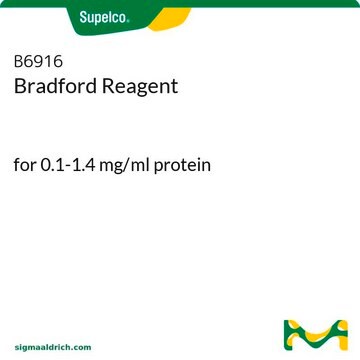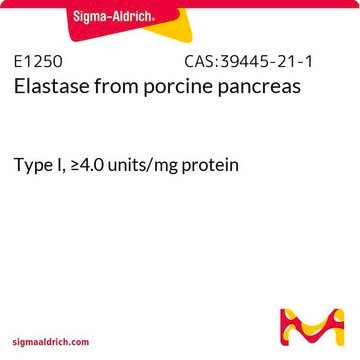N9879
NADase from porcine brain
≥0.007 unit/mg solid
Synonym(s):
DPN Nucleosidase, NAD+ glycohydrolase
Sign Into View Organizational & Contract Pricing
All Photos(1)
About This Item
CAS Number:
MDL number:
UNSPSC Code:
12352204
NACRES:
NA.54
Recommended Products
form
powder
Quality Level
specific activity
≥0.007 unit/mg solid
solubility
insoluble
storage temp.
−20°C
General description
NADase is a glycohydrolase that catalyzes ADP-ribose transfer.
Application
NADase from porcine brain has been used in a study to investigate histidine and related compounds resulting from catalyzed ADP-riboslyation. It has also been used in a study to investigate the preparation of arylazide-substituted pyridine adenine dinucleotides for photoaffinity labeling.
Biochem/physiol Actions
Nicotinamide has been shown to inhibit NADase activity.
Unit Definition
One unit will hydrolyze 1.0 μmole of β-NAD to nicotinamide and ADP-ribose per min at pH 7.3 at 37 °C.
Physical form
Acetone-dried powder
Storage Class Code
11 - Combustible Solids
WGK
WGK 3
Flash Point(F)
Not applicable
Flash Point(C)
Not applicable
Personal Protective Equipment
dust mask type N95 (US), Eyeshields, Gloves
Choose from one of the most recent versions:
Certificates of Analysis (COA)
Lot/Batch Number
Don't see the Right Version?
If you require a particular version, you can look up a specific certificate by the Lot or Batch number.
Already Own This Product?
Find documentation for the products that you have recently purchased in the Document Library.
D San Segundo et al.
Transplantation proceedings, 44(9), 2676-2678 (2012-11-14)
Posttransplant infection after lung transplantation is a common feature due to the immunodeficiency induced by the immunosuppressive load. To assess B-cell subsets in lung transplant recipients suffering at least one episode of infection within the first year posttransplantation. Twenty-eight lung
H Kim et al.
Molecular and cellular biochemistry, 138(1-2), 237-243 (1994-09-01)
NAD glycohydrolases are the longest known enzymes that catalyze ADP-ribose transfer. The function of these ubiquitous, membrane-bound enzymes has been a long standing puzzle. The NAD glycohydrolases are briefly reviewed in light of the discovery by our laboratory that NAD
Nicholas Chiorazzi
Hematology. American Society of Hematology. Education Program, 2012, 76-87 (2012-12-13)
Several prognostic markers based on genetic, phenotypic, and molecular characteristics of chronic lymphocytic leukemia (CLL) B cells have emerged in the past decade. The clinical utility of these newer prognostic indicators, alone or in combination with each other and other
Ding-bao Chen et al.
Zhonghua bing li xue za zhi = Chinese journal of pathology, 41(9), 607-612 (2012-11-20)
To study the clinical and histopathologic features, diagnosis, pathogenesis and therapy of post-transplant lymphoproliferative disorders (PTLD). The clinical and pathologic features of 15 cases of PTLD were retrospectively analyzed by light microscopy, immunohistochemistry and in-situ hybridization, according to the updated
K A Wall et al.
The Biochemical journal, 335 ( Pt 3), 631-636 (1998-10-31)
Carba-NAD and pseudocarba-NAD are carbocyclic analogues of NAD+ in which a 2,3-dihydroxycyclopentane methanol replaces the beta-d-ribonucleotide ring of the nicotinamide riboside moiety of NAD+ [Slama and Simmons (1988) Biochemistry 27, 183-193]. These carbocyclic NAD+ analogues, related to each other as
Our team of scientists has experience in all areas of research including Life Science, Material Science, Chemical Synthesis, Chromatography, Analytical and many others.
Contact Technical Service








